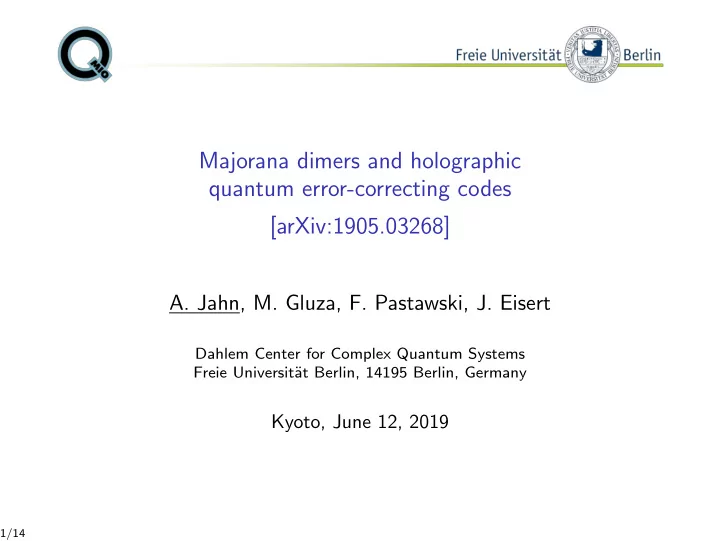

Majorana dimers and holographic quantum error-correcting codes [arXiv:1905.03268] A. Jahn, M. Gluza, F. Pastawski, J. Eisert Dahlem Center for Complex Quantum Systems Freie Universit¨ at Berlin, 14195 Berlin, Germany Kyoto, June 12, 2019 1/14
AdS/CFT correspondence The general idea: QFT in d dimensions, Gravity in d + 1 dimensions, strongly coupled weakly coupled ≃ (Antoniadis et al., Science 340 (2013)) (STAR detector image, Brookhaven RHIC) The more specific idea: J. M. Maldacena, “The Large N limit of superconformal field theories and supergravity,” Adv. Theor. Math. Phys. 2 (1998) 231. E. Witten, “Anti-de Sitter space and holography,” Adv. Theor. Math. Phys. 2 (1998) 253. 2/14
AdS/CFT correspondence Key features: ◮ Einstein gravity on AdS d +1 ↔ conformal field theory (CFT d ) ◮ AdS d +1 boundary = CFT d spacetime ◮ Bulk dynamics ≡ boundary dynamics ( Z AdS = Z CFT ) ◮ Features quantum error-correction of bulk information (full spacetime) (timeslice) 3/14
Tensor networks Quantum state on N physical sites as a tensor T : � | ψ � = T j 1 ,..., j N | j 1 , . . . , j N � j 1 ,..., j N =0 , 1 Simple ansatz for T : Contraction over a product of tensors U i , j , k V l , m , n W o , p , q i k l n o q Building blocks: j m p i , k , n U i , j , k V k , m , n W n , p , i ⇒ T j , m , p = j m p Network structure of contracted tensor indices ≡ Entanglement structure of the quantum state 4/14
Tensor networks + AdS/CFT Tensor network holography: Mapping between bulk tensor content and boundary state Boundary Bulk ≡ bulk geometry ≡ tensor network structure boundary regions ≡ open tensor indices 5/14
The hyperbolic pentagon code (HyPeC) Tensor network for holographic quantum error correction ⋆ : Hyperbolic pentagon tiling of perfect tensors corresponding to encoding isometry of [[5 , 1 , 3]] quantum error-correcting code. ⋆ F. Pastawski, B. Yoshida, D. Harlow and J. Preskill, JHEP 1506 , 149 (2015). 6/14
The hyperbolic pentagon code (HyPeC) HyPeC properties: ◮ Each pentagon tile encodes a logical qubit ◮ Entire network encodes bulk qubits on boundary ◮ Logical qubit reconstructable from different boundary regions ≃ 7/14
HyPeC → Majorana dimers Pentagon logical state is spanned by basis states ¯ 0 and ¯ 1. These states are characterized by Majorana dimers ⋆ : 1 2 1 2 10 3 10 3 9 4 9 4 � ¯ � � ¯ � � � 0 5 = 1 5 = 8 5 8 5 7 6 7 6 Each arrow between Majorana modes j → k defines an operator γ j + i γ k that annihilates the total state. What happens during tensor contraction of dimer states? ⋆ B. Ware et al., Phys. Rev. B 94 , 115127 (2016). 8/14
HyPeC → Majorana dimers Dimer state contraction ≡ “Fusing” of dimers along edges! Applied to basis-state HyPeC: Geodesic structure of dimers → On boundary: Average polynomial 1 / d decay of correlations! 9/14
HyPeC → Majorana dimers General HyPeC: Local superpositions of ¯ 0 and ¯ 1 inputs: 10 10 10 9 9 9 1 1 1 2 2 2 8 8 8 = + α , β α β 7 7 7 3 3 3 4 4 4 6 6 6 5 5 5 ⇒ | ψ � = Contraction of n tiles ≡ sum of 2 n Majorana dimer states | ψ k � . But: � ψ j | γ a γ b | ψ k � ∝ δ j , k . 2-point functions become easy! 10/14
HyPeC → Majorana dimers Entanglement between regions mediated by dimers: A C Realizes holographic Ryu-Takayanagi 1 formula S A = | γ A | γ A 4 G N with the minimal bulk geodesic γ A . A Resemblance to the holographic bit thread 2 proposal! 1 S. Ryu and T. Takayanagi, Phys. Rev. Lett. 96 , 181602 (2006). 2 M. Freedman and M. Headrick, Commun. Math. Phys. 352 (2017) no.1, 407. 11/14
Recommend
More recommend